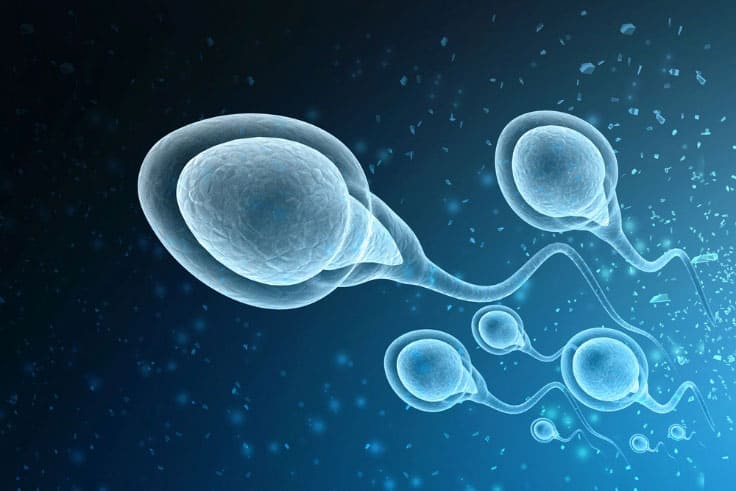Ejaculatory Duct Obstruction & Resection in Los Angeles & San Francisco, CA
Understanding a Common Barrier to Male Fertility

Some men have difficulty becoming fathers because of a blockage in the male reproductive tract that prevents sperm from being released into the ejaculate. A blockage in the ejaculatory duct is called ejaculatory duct obstruction (EDO). This problem, which affects 1-5% of men with fertility problems, is congenital for some men, but may also develop in adults over time and be due to cysts, small stones, infections, and surgical procedures.
Fortunately, having EDO does not need to be a permanent obstacle. Dr. Paul Turek, a board-certified urologist, has pioneered and published techniques for diagnosing and treating EDO that are now used by male fertility specialists around the world. Patients in California have the privilege of seeking care directly from one of the foremost experts in EDO care and vastly increase their chances of becoming parents.
What Are the Ejaculatory Ducts?
During ejaculation, two ducts carry semen from the seminal vesicles to the urethra, where it exits the penis in the ejaculate. A blockage or obstruction can develop in one or both of the ejaculatory ducts, preventing sperm from getting into the ejaculate. Sometimes the ducts are blocked from birth (i.e., congenital) and in other cases they are acquired.
Dr. Turek has described several types of EDO. Complete or classic EDO is the obstruction of both ducts and presents with low ejaculate volumes in the setting of no sperm or azoospermia. Incomplete or partial EDO is the obstruction of one of the ducts or partial obstruction of both ducts. In this case ejaculated sperm are present but the volume, count and motility are typically all low. Functional EDO presents as classic ejaculatory duct obstruction without anatomical evidence of a physical blockage.
Table 1: Classification of Ejaculatory Duct Obstruction By Semen Analysis
| Incomplete or Partial | Complete | Functional | |
|---|---|---|---|
| Ejaculate volume | Low or Low-normal | Low | Low |
| Sperm count | Low | Absent | Absent or low |
| Sperm motility | Low | Absent | Absent or low |
| Ejaculate fructose | Present | Absent | Absent or low |
Potential Symptoms of EDO

Patients with EDO may have:
- Less semen fluid in the ejaculate than when younger or when compared to other men
- Pain during sexual activity or during or following ejaculation
- Extremely low sperm motility (<10%) in the setting of normal or low sperm counts
- Blood in semen (hematospermia)
- Infertility
However, most men do not notice any symptoms, which makes this a subtle and often missed diagnosis as a cause of male infertility.
How Is Ejaculatory Duct Obstruction Diagnosed?
Diagnosing EDO involves a complete sexual and medical history and physical examination of the testes and genitalia as well as lab testing that examines the semen analysis and reproductive hormones including follicle stimulating hormone (FSH) and testosterone levels.

Transrectal ultrasound (TRUS) is the workhorse medical tool used to help diagnose suspected cases of EDO. It can reveal dilated seminal vesicles, cysts blocking the ejaculatory ducts or calcifications in the ducts. But, as Dr. Turek’s research has shown, TRUS alone is not sufficient to make the diagnosis in many cases. He has found TRUS to be very good at suggesting that obstruction is present, similar to a taking a snapshot picture with a camera. However, it should be used in combination with other diagnostic techniques that provide a more “dynamic” image of the system to make a truly accurate diagnosis. These adjunctive techniques include seminal vesicle sperm aspiration, TRUS-guided seminal vesiculography, ejaculatory duct chromotubation and ejaculatory duct manometry.
Seminal vesicle sperm aspiration involves looking at the fluid within the seminal vesicle to confirm whether sperm is being made. The finding of high numbers of sperm in the seminal vesicle fluid suggests an obstruction. However, this technique does not help to identify the site of the blockage or differentiate between physical blockage and functional obstruction. The addition of chromotubation and ejaculatory duct pressure measurements (manometry) techniques greatly helps Dr. Turek accurately distinguish between EDO cases due to blockage that may be treated surgically from those that are dysfunctional and will not respond to surgery. This help him to avoid unnecessary surgery whenever possible.

Treating Ejaculatory Duct Obstruction
The most effective way to treat ejaculatory duct obstruction is transurethral resection of the ejaculatory ducts (TURED). This minimally invasive treatment uses an ultrasound-guided instrument to remove a lump of tissue (specifically the verumontanum) near the ejaculatory ducts to unclog the blockage. This can be performed on one or both sides depending on the patient’s diagnosis.
About 80-90% of men who undergo TURED see a significant improvement in their sperm count. And the improvements in semen quality occur immediately after the procedure, unlike the 3-6 months of time it takes to treat other forms of male infertility. Better yet, more than 30% of men who have had TURED are able to achieve natural pregnancies with their partners. If the obstruction is not improved with the TURED procedure, options like sperm retrieval in tandem with IVF/ICSI can still help couples to become biological parents.
During TURED, the ducts are opened to allow for the normal flow of ejaculate. At least 75 percent of men who undergo TURED will have a marked improvement in semen quality and a 30 percent natural pregnancy rate can be expected.
If the obstruction cannot be repaired, sperm retrieval techniques can be considered and the sperm used for pregnancy with IVF-ICSI. Dr. Turek can review these options with you and help you decide how to proceed.
Why You Should Choose the Turek Clinic for EDO Treatment

As the developer of several diagnostic tests for EDO and a pioneer who has refined the minimally invasive TURED procedure, Dr. Turek is the clear choice for men who have been diagnosed with obstructive azoospermia due to EDO. Throughout his career, Dr. Turek has helped thousands of men who were considered “infertile” to fulfill their dreams of becoming biological fathers. He understands how to best diagnose and treat ejaculatory duct obstruction in the least invasive way so that his patients can get back to their normal routine as soon as possible — including having babies with sex!
In the cases in which a man’s fertility problems are not helped with EDO treatment, Dr. Turek continues to work with patients to find other ways to procure sperm to fertilize the partner’s egg. Receiving this degree of complete care offered by the Turek Clinic’s friendly, knowledgeable team is how patients can feel confident that they are doing everything possible to overcome fertility obstacles. For a consultation, call 1-888-TUREK-MD.









